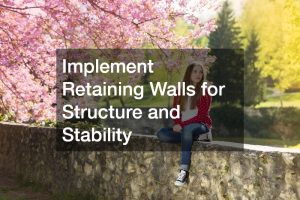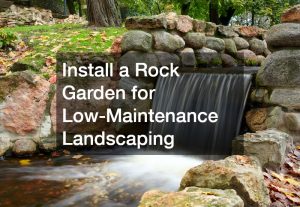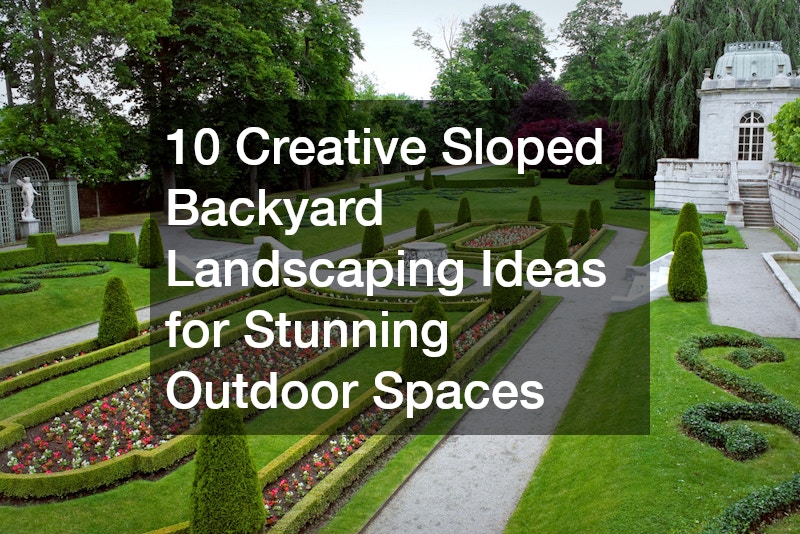Sloped backyards may seem like a landscaping challenge, but with a little creativity, they can become beautiful, functional outdoor spaces. From terraced gardens to rock features, there are many ways to make your sloped backyard not only usable but also an eye-catching retreat. Proper planning and design can turn steep, awkward spaces into a valuable extension of your home. Here are 10 sloped backyard landscaping ideas that will help you maximize your outdoor space, prevent erosion, and improve your home’s curb appeal.
1. Create Tiered Garden Beds for an Abundance of Greenery

One of the easiest and most visually appealing ways to make the most of a sloped backyard is by creating tiered garden beds. These beds break up the slope into manageable, flat areas where you can plant a variety of flowers, shrubs, or even vegetables. Tiered gardens also add depth and dimension to your yard, making it appear larger and more structured. Whether you want a lush flower garden or a productive vegetable plot, tiered beds are an excellent choice.
Why Choose Tiered Garden Beds?
- Enhanced Aesthetic Appeal: They create visual layers, drawing the eye upward and making the space feel more dynamic.
- Improved Planting Opportunities: Each tier offers a distinct environment, allowing you to experiment with different plants based on sunlight and drainage.
- Erosion Control: The tiered structure helps prevent soil erosion, keeping your garden beds intact even after heavy rain.
Actionable Tips:
- Choose Sturdy Materials: Use materials like timber, stone, or concrete to create sturdy retaining walls that separate the tiers. Make sure they’re properly anchored to prevent them from collapsing under pressure.
- Design Each Tier with a Purpose: Plant taller plants at the top and smaller, ground-covering plants near the bottom to create balance. Consider integrating a drip irrigation system to ensure your plants receive adequate water without washing out the soil.
- Use Contrasting Textures: Combine different textures and colors of plants to make each tier stand out, such as using ornamental grasses in one section and vibrant flowers in another.
For a complete guide, check out how to build tiered garden beds.
2. Implement Retaining Walls for Structure and Stability

If you want to control erosion while adding visual appeal, retaining walls are an excellent option. Retaining walls help to prevent soil runoff and create flat, usable spaces on a slope, while also adding a sense of structure to the landscape. Retaining walls can transform a steep slope into a series of flat terraces that are perfect for gardens, seating areas, or pathways.
Benefits of Retaining Walls:
- Erosion Prevention: They act as barriers that hold the soil in place, preventing it from washing away during heavy rains.
- Maximized Space: Retaining walls can transform an unusable slope into a series of flat, functional areas.
- Customizable Design: You can use various materials like stone, brick, or wood, making it easy to match the aesthetic of your home.
Actionable Tips:
- Select the Right Materials: For a more organic look, choose natural materials like stone or bricks, or use concrete blocks for a modern, clean finish. Opt for materials that complement your home’s exterior for a cohesive look.
- Consider Height and Placement: Keep in mind local regulations about the height of retaining walls, and stagger them if needed. Aim to create terraces that are 2-3 feet tall to minimize structural pressure.
- Incorporate Drainage Systems: Make sure to include proper drainage behind the walls to avoid water buildup that could damage the structure. Use perforated pipes, gravel backfill, and weep holes to direct water away from the wall.
For more inspiration on retaining walls, visit this article on retaining wall tips.
3. Install a Rock Garden for Low-Maintenance Landscaping

If you’re looking for a low-maintenance, drought-resistant option, consider adding a rock garden to your sloped backyard. Rock gardens add natural beauty and are perfect for areas with minimal water. They can fill the space between terraced levels or serve as a focal point on a gentle slope.
Benefits of Rock Gardens:
- Minimal Watering Requirements: Rocks help retain moisture, making rock gardens ideal for dry or arid climates.
- Year-Round Visual Interest: Rocks provide a sculptural element to your landscape, making it look attractive even when plants are dormant.
- Reduced Maintenance: With fewer plants to care for, rock gardens require less upkeep compared to traditional gardens.
Actionable Tips:
- Plan for Stability: Choose rocks of various sizes to create a natural look, but make sure to place the largest stones at the bottom for stability.
- Mix Textures and Colors: Combine different types of rocks, like river stones, boulders, and gravel, to create visual interest.
- Include Hardy Plants: Add drought-resistant plants like succulents, lavender, or sedums around the rocks. Consider spacing them irregularly for a more natural feel.
For more ideas, read about designing rock gardens.
4. Design an Outdoor Staircase for Easy Navigation
For steep slopes, an outdoor staircase is not just practical—it can also be a beautiful focal point in your backyard design. Outdoor stairs make it easier to navigate different levels of your yard while enhancing the landscape’s structure. By using attractive materials and thoughtful design, stairs can add both functionality and flair to your sloped backyard.
Benefits of Outdoor Stairs:
- Improved Access: Stairs make it easy to access different areas of a steep backyard.
- Visual Structure: Well-designed steps can serve as an architectural feature, drawing attention to various parts of the yard.
- Increased Safety: Stairs are safer than slopes, especially in wet or icy conditions.
Actionable Tips:
- Use Durable Materials: Opt for materials like wood, stone, or concrete to create steps that blend with your landscape design. Make sure they’re properly installed to handle the weight and environmental conditions.
- Include Handrails for Safety: For steep slopes, adding handrails is crucial for safety. Choose handrails that match the design of your stairs, such as metal or wood.
- Add Lighting for Ambiance and Safety: Incorporate lighting along the steps to make the area safer to use at night. Consider LED strip lights under each step or lantern-style fixtures along the path.
For more information on building outdoor stairs, check out this detailed guide.
5. Incorporate a Water Feature for a Relaxing Atmosphere
Adding a water feature to your sloped backyard can bring a sense of tranquility and elevate the entire landscape design. Water naturally flows downhill, making a slope the perfect setting for features like cascading waterfalls, tiered fountains, or streams. These water elements not only enhance the visual appeal but also introduce soothing sounds that can create a relaxing outdoor environment.
Benefits of Water Features:
- Natural Fit for Slopes: Sloped terrains are ideal for creating waterfalls and streams that mimic natural landscapes.
- Creates a Calming Ambience: The sound of flowing water can create a peaceful, serene atmosphere, making your backyard a perfect retreat.
- Attracts Wildlife: Water features can draw birds, butterflies, and other wildlife to your garden, adding life and movement to your space.
Actionable Tips:
- Use the Natural Slope to Your Advantage: Install a waterfall at the top of your slope and let the water flow downward into a pond or basin. This uses the natural gradient of the land, reducing the need for complicated construction.
- Select Durable Materials: Use natural stones or boulders to line the water feature, creating a seamless blend with the landscape. Make sure to install a waterproof liner and pump system to keep water circulating.
- Include Aquatic Plants: Add water plants like water lilies or lotus to ponds and basins to enhance the natural look and maintain the water’s cleanliness.
For more inspiration, explore this guide to backyard water features.
6. Plant a Hillside Vineyard or Orchard for a Productive Slope
Transforming your sloped backyard into a hillside vineyard or orchard is not only aesthetically pleasing but also highly productive. Grapevines, fruit trees, and other edible plants thrive on slopes, where drainage is often better than on flat ground. You can create a lush, fruitful landscape that offers both beauty and bounty.
Benefits of Vineyards and Orchards:
- Productive Use of Space: Rather than leaving your slope unused, plant grapevines, fruit trees, or berry bushes for a beautiful and edible garden.
- Better Drainage for Plants: Slopes typically have better drainage, which is ideal for growing plants that don’t like standing water.
- Unique Visual Appeal: Rows of grapevines or fruit trees create a striking visual pattern, making your landscape look orderly and well-designed.
Actionable Tips:
- Choose the Right Varieties: For a vineyard, select grape varieties suited to your climate. For an orchard, choose fruit trees like apple, pear, or peach that can thrive in your area.
- Install Proper Supports: Vineyards need trellises or wire systems to support the growth of grapevines. Use a sturdy frame to ensure your plants grow upward and spread evenly.
- Space Trees Properly: When planting an orchard, space trees 10-15 feet apart to allow for full growth and easy harvesting. Consider planting dwarf or semi-dwarf varieties for smaller slopes.
For further guidance, check out this resource on starting a backyard vineyard.
7. Build a Cozy Fire Pit Terrace for Year-Round Enjoyment
A fire pit terrace is a fantastic way to make use of your sloped backyard while creating a cozy space for relaxation and social gatherings. Terraced seating areas surrounding a fire pit create a natural gathering spot where friends and family can enjoy cool evenings around the fire. Plus, the tiered design makes it easier to incorporate comfortable seating and natural materials like stone or brick.
Benefits of a Fire Pit Terrace:
- Year-Round Usability: Fire pits make outdoor spaces enjoyable during cooler months, extending the time you can spend outdoors.
- Natural Gathering Spot: A fire pit serves as a focal point, encouraging family and guests to gather around for warmth and conversation.
- Adds Value to Your Home: Outdoor living spaces like fire pits are highly desirable and can increase your property’s value.
Actionable Tips:
- Use Heat-Resistant Materials: Choose materials like stone, brick, or concrete for the fire pit to ensure safety and longevity.
- Incorporate Tiered Seating: Build terraced seating into the slope, with each row at a different level to ensure everyone has a clear view of the fire.
- Add Comfortable Elements: Include cushions, throw blankets, and outdoor rugs to make the space cozy. You can also install built-in seating around the fire pit for a more permanent setup.
For fire pit safety tips and design inspiration, visit how to design a fire pit area.
8. Install a Multi-Level Deck for Entertaining Spaces
A multi-level deck is a practical and stylish solution for steep backyard slopes. Decks can be built at various heights to match the slope’s grade, creating distinct zones for dining, relaxing, and entertaining. This not only makes your backyard more usable but also adds an architectural feature that enhances the aesthetic appeal of your home.
Benefits of Multi-Level Decks:
- Maximizes Usable Space: A multi-level deck breaks up a steep slope, providing multiple flat surfaces for outdoor activities.
- Creates Separate Zones: Each level of the deck can serve a different function, such as dining, lounging, or gardening.
- Increases Home Value: A well-designed deck adds to the living space of your home and is a sought-after feature for potential buyers.
Actionable Tips:
- Use Composite Materials: Choose low-maintenance materials like composite decking, which resists rot, warping, and insect damage.
- Incorporate Built-In Planters and Seating: To make the most of your deck’s space, integrate planters, seating areas, and storage directly into the design.
- Ensure Proper Support: A sloped deck requires extra structural support, so consult with a professional to ensure the design meets local building codes and is safe.
To get started with your deck design, check out multi-level deck design ideas.
9. Add Sloped Walkways for Seamless Accessibility
For homeowners who want easier access to all areas of their sloped backyard, walkways are a must. Creating winding or gently sloping paths can enhance the flow of your landscape, making it easy to move from one level to another. Walkways also help reduce erosion by providing a stable surface for foot traffic.
Benefits of Sloped Walkways:
- Improved Accessibility: Walkways provide easy access to different levels of your backyard without the need for stairs.
- Erosion Control: By directing foot traffic onto designated paths, walkways help prevent soil compaction and erosion in other areas.
- Visual Flow: A well-designed walkway can guide the eye through the landscape, creating a sense of continuity and flow.
Actionable Tips:
- Choose Durable Materials: Use materials like flagstone, pavers, or gravel to create a walkway that complements your landscape and can withstand heavy use.
- Incorporate Gentle Curves: Avoid steep inclines by designing the walkway to wind gently through the landscape. This creates a more natural feel and makes it easier to walk.
- Add Border Plants: Frame your walkway with low-growing plants, flowers, or ground cover to soften the edges and add beauty.
For more walkway design ideas, check out creating sloped garden paths.
10. Use Ground Covers to Beautify and Stabilize Slopes
Ground covers are an excellent choice for homeowners looking to fill large sloped areas with low-maintenance greenery. These plants spread quickly, preventing erosion while providing a lush, green carpet that requires minimal care. From ivy to creeping thyme, ground covers can enhance the visual appeal of your slope while solving common landscaping challenges.
Benefits of Ground Covers:
- Erosion Prevention: Ground covers spread rapidly, helping to hold soil in place and prevent erosion.
- Low Maintenance: Most ground covers are hardy and drought-tolerant, making them easy to care for once established.
- Visual Cohesion: A uniform ground cover creates a seamless look that can tie together different parts of your sloped landscape.
Actionable Tips:
- Choose Hardy, Spreading Plants: Opt for plants like creeping juniper, vinca minor, or sedum, which spread quickly and require little maintenance.
- Plant in a Staggered Pattern: Space plants in a staggered formation to ensure even coverage and prevent bare spots.
- Combine Ground Covers with Hardscaping: Use ground covers to soften the edges of pathways, staircases, or retaining walls, creating a balanced blend of greenery and structure.
For more on ground cover options, explore this guide to erosion control plants.
By implementing these creative sloped backyard landscaping ideas, homeowners can turn a challenging slope into a beautiful, functional outdoor space. From terraced garden beds to multi-level decks and cozy fire pit terraces, these landscaping solutions not only improve the look of your yard but also increase its usability and value. Whether you’re tackling a small slope or a large hillside, these tips will help you create a stunning landscape that enhances your home and lifestyle.
